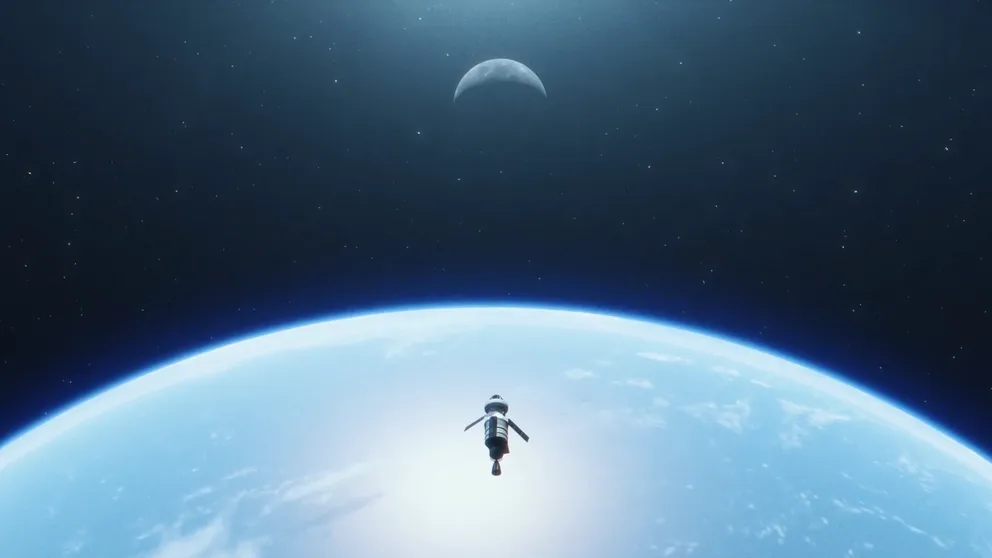'This is not just Apollo 18': Artemis geology team prepares for astronaut exploration on Moon's South Pole
As a planetary scientist with the U.S. Geological Survey, Dr. Lauren Edgar has worked with astronauts practicing fieldwork on Earth and on robotic missions like NASA’s Mars Curiosity rover. She's part of the Artemis III geology team, helping to identify key strategies and science goals for the first astronaut mission to the Moon in more than 50 years.
Artemis 1 mission: Relive Orion's historic journey to the moon before splashdown
Splashing down on December 11, the successful completion of the Artemis I mission paves the way for future expeditions to Mars and other destinations in the solar system.
Unlike the Apollo missions exploring sunlit areas of the Moon, the Artemis astronauts will be landing in the shadowed region of the lunar South Pole, offering new challenges for exploration.
"This is going to be very different than Apollo. This is not just Apollo 18. This is a completely different way of getting there, and the exploration strategies will be different, and the science goals will be different," said Dr. Lauren Edgar, the deputy principal investigator for the Artemis III geology team.
NASA recently selected a team to develop a science plan for the Artemis III mission, the first astronaut moon landing in over 50 years. Artemis III Geology Principal Investigator Dr. Brett Denevi, with Johns Hopkins University Applied Physics Laboratory, will lead a team of diverse experts to identify key strategies and science goals for the astronaut mission to the Moon. NASA is targeting late 2025 for the Artemis III moon landing, which is dependent on the Artemis II mission around the Moon late next year.
ARTEMIS II ASTRONAUTS MEET THEIR SPACECRAFT AHEAD OF LATE 2024 MOON LAUNCH
As a planetary scientist with the U.S. Geological Survey, Edgar has worked with astronauts practicing geology fieldwork on Earth and robotic missions like NASA’s Mars Curiosity rover.
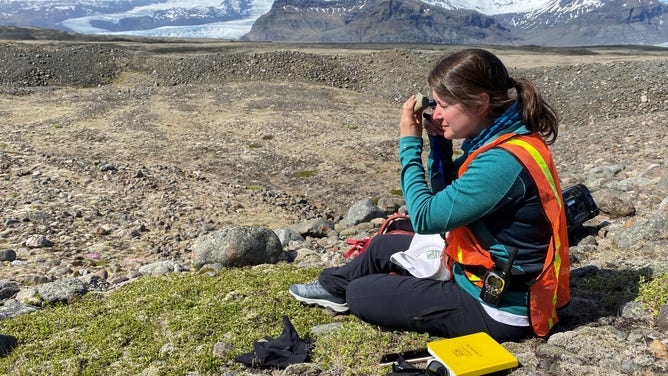
Lauren Edgar, with the USGS Astrogeology Science Center, uses a hand lens to identify minerals in a sample from a complex esker in Iceland. (Image: USGS)
(USGS)
"We're going to the South Pole because we're really interested in volatiles, the things that would vaporize easily in the presence of sunlight. So water, things like that, and the different ices that we might expect to find there," Edgar said. "That will tell us a lot about the evolution of volatiles in the solar system in general."
Water ice is a crucial reason why NASA has selected 13 possible landing regions on the Moon’s South Pole. NASA and its international partners hope to use water on the Moon to make fuel and drinking water.
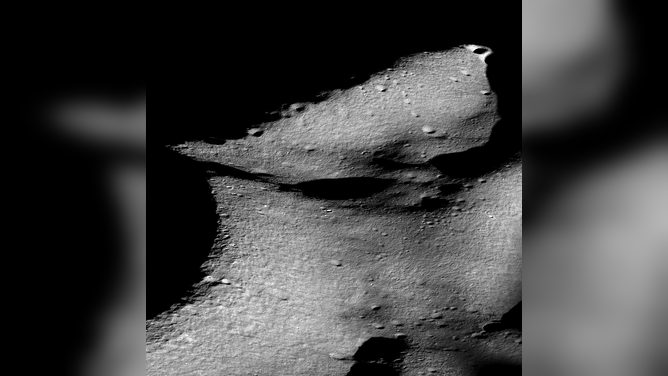
Oblique view of the rim of Shackleton crater (on the left) and the Shackleton - de Gerlache ridge that runs from middle left to upper right. This area is under consideration for the Artemis 3 crewed landing scheduled for 2025. (Image: NASA/GSFC/Arizona State University)
Depending on the launch window and the need to land in sunlight, engineering constraints may play the most significant role in picking where the Artemis III landing happens. However, all 13 regions will provide astronauts access to important geological findings.
NASA ASTRONAUTS WILL LAND IN SHADOWED REGIONS ON THE MOON'S SOUTH POLE
"Those 13 regions all have similar access to impact ejecta from a really old impact crater that might tell us a lot about the early formation of the Moon, access to locations where you might expect to see volatiles, anywhere we can kind of do some of the space weathering analysis that we're interested in," Edgar said. "There'll be differences in the geology, but broadly, all 13 give you some access to different parts of that."
Ahead of the astronauts, NASA has payloads on several private robotic missions that will help the geology team identify where those volatiles are distributed and what the astronauts might experience when they arrive. The types of rocks found and collected by astronauts on the South Pole will be unlike any of the samples brought back from the Apollo program.
Edgar and her colleagues will try to create a science game plan that will help the astronauts prepare for exploring another world.
"Doing geology on other planets is really challenging," Edgar said.
Astronauts will have to navigate on the Moon and understand where they are relative to different lunar features. Edgar said lighting will be challenging because the South Pole is primarily in darkness.
"Being there on the surface, they're going to have terrain challenges in terms of boulders and impact craters and hazards they need to try and avoid. You also have to bring your entire life support system with you on your back. So navigating around in the suit with the tools, all of that will be challenging," Edgar said.
Moon simulations on Earth's landscapes
NASA astronauts typically receive three phases of geology training. Phase one begins as an astronaut candidate, and then when they are selected, NASA astronauts undergo in-field expeditions, gaining the skill set needed for geology.
"Phase three is mission specific. So once that Artemis III crew is named, and we know at least a couple of the landing sites that might be options for them, you can do more specific training geared towards (those sites)," Edgar said.

File photo: NASA astronauts Raja Chari and Kayla Barron in 2017 as astronaut candidates examining samples during geology training in Arizona. Photo Credit: (NASA/Bill Stafford)
(NASA)
Scientists will help the astronauts understand their landing area and what they might see, including what types of observations and samples are needed.
Once the landing sites are narrowed down, astronauts can undergo more training on Earth with analogs replicating the conditions they could see on the lunar South Pole.
Analogs for the Moon and Mars are located all over the world.
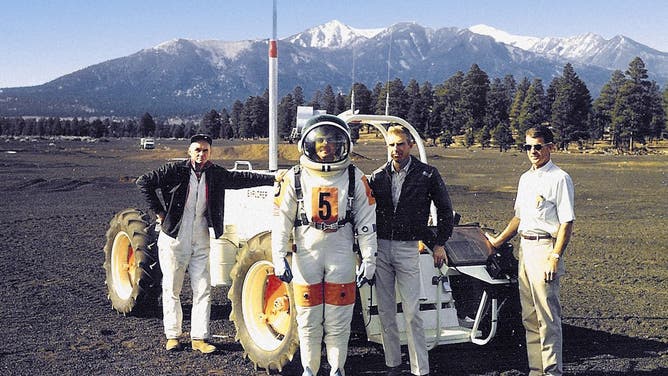
Photo caption: USGS Field Test Support Unit (left to right) Dick Wiser, John Hendricks, Bill Tinnin and Putty Mills with the Explorer, a lunar rover vehicle simulator at Cinder Lake Crater Field east of Flagstaff, December 1968. (Image: USGS)
(USGS)
NASA CONDUCTS LUNAR ROVER, MOONWALKING TESTS IN ARIZONA TO PREPARE FOR MOON LANDING
"Flagstaff, Arizona, where the U.S. Geological Survey is, is a great spot for training, a place that we've done a lot, And also the reason why our center exists in Flagstaff was for training the Apollo astronauts back in the sixties," Edgar said.
Edgar said that analog astronauts practice for Mars missions near the Kilauea volcano in Hawaii and Iceland is another common analog for the Moon and Mars.
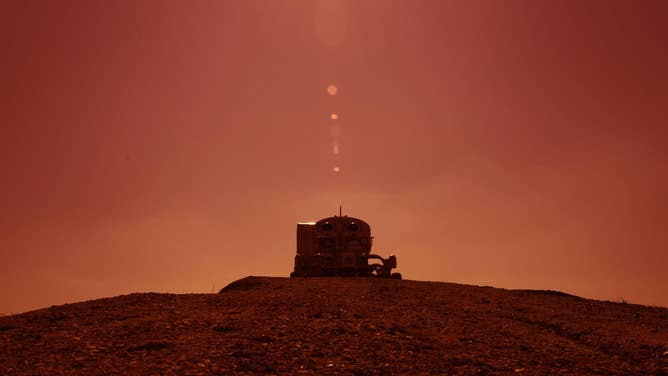
A photo of NASA's Lunar Electric Rover cresting a hill at Black Point Lava Flow in Arizona, the site of the 2008 Desert RATS - or Research and Technology Studies - tests. (Image Credit: NASA/Regan Geeseman)
NASA's ultimate goal is to establish a sustainable presence on the Moon and eventually Mars. Edgar says in-situ resource utilization, or using planetary resources, will help further exploration strategies for Mars.
"All of the technology that's needed to get there, the exploration strategies, is kind of that concept of operations and procedures that we can test out the infrastructure that is needed to support humans and the in-situ resource utilization. What can we use in place that we don't have to bring with us?" Edgar said. "Those are all things that will help us eventually bring humans to Mars."
